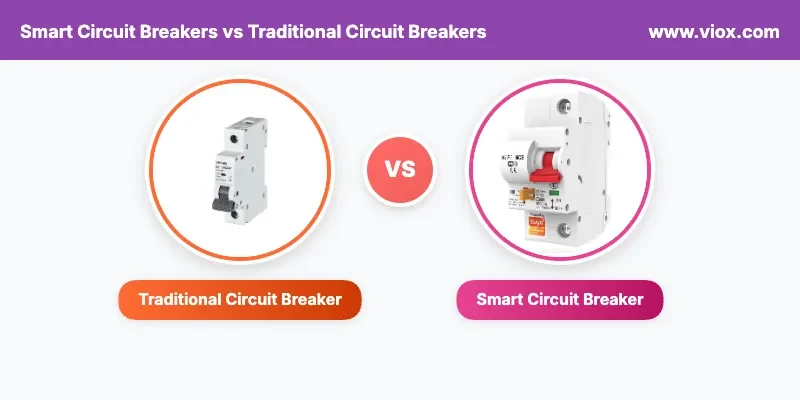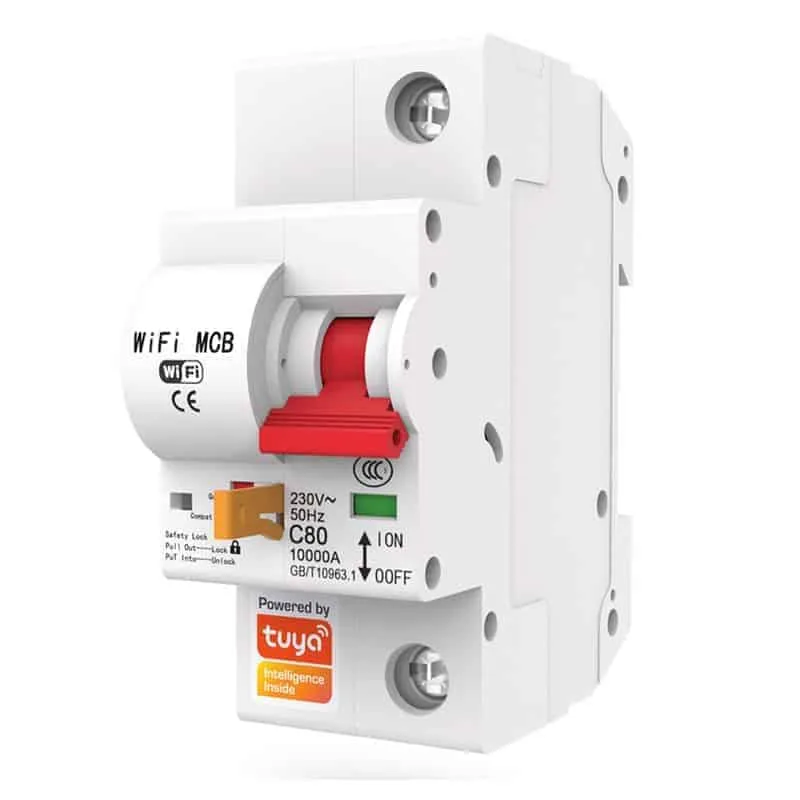スマートブレーカーは、単なる保護機能以上の機能を提供します。従来のブレーカーは、単に過負荷に対する安全装置として機能するだけですが、スマートブレーカーはリアルタイムデータ、リモートコントロール、そしてエネルギー最適化を提供します。スマートブレーカーと従来のブレーカーのどちらを選ぶかお悩みなら、この包括的なガイドが、ご家庭の電気安全、エネルギー効率、そして将来への備えといったニーズに最適な選択をお手伝いします。
迅速に回答: スマートブレーカーは、従来のブレーカーの保護機能に加え、Wi-Fi接続、リモートモニタリング、エネルギー管理、スマートフォンによる操作機能を備えています。従来のブレーカーは1台あたり$5~250ドルですが、スマートブレーカーは$120~500ドル以上と幅広く、長期的な省エネと強化された安全機能を備えています。
スマート回路ブレーカーと従来の回路ブレーカーの違いは何ですか?
従来のサーキットブレーカー:信頼できる基盤
従来型のブレーカーは、過負荷や短絡による潜在的な損傷から回路を保護するために設計された自動電気スイッチです。これらの機械装置は、電気系統の故障を検知すると自動的に電力を遮断することで、何十年にもわたって家庭を守ってきました。
主な特徴:
- 純粋に機械的な操作
- トリップ後は手動リセットが必要
- 基本的な過電流保護
- 接続機能なし
- コスト範囲: ブレーカーあたり $5-250
スマートサーキットブレーカー:デジタル進化
スマート回路ブレーカーは、通常のブレーカーのすべての機能に加え、リモート監視と制御、リアルタイムの使用状況データの収集機能を備え、ユーザーに電気システムに対するこれまでにない制御を提供します。
高度な機能:
- Wi-Fi、Bluetooth、またはZigbee接続
- スマートフォンアプリ制御
- リアルタイムのエネルギー監視
- リモートオン/オフ機能
- 従来のシステムに比べて少なくとも$1,000の価格プレミアム
スマートサーキットブレーカーと従来型サーキットブレーカー:完全比較表
| 特徴 | 従来のサーキットブレーカー | スマートサーキットブレーカー |
|---|---|---|
| 基本的な保護 | ✅ 過負荷と短絡 | ✅ 過負荷と短絡 |
| 単位当たりコスト | $5-250 | $120-500+ |
| 設置費用 | ブレーカーあたり$313-375 | ブレーカーあたり$400-800 |
| リモコン | ❌ 手動のみ | ✅ スマートフォンアプリ |
| エネルギー監視 | ❌ データなし | ✅ リアルタイム使用状況 |
| 接続性 | ❌ なし | ✅ Wi-Fi/Bluetooth |
| 通知 | ❌ なし | ✅ インスタントアラート |
| 負荷管理 | ❌ 静的 | ✅ 動的最適化 |
| メンテナンス | 手動検査 | 予測アラート |
| 寿命 | 25~40歳 | 15~25年(推定) |
| NECコンプライアンス | ✅ 完全準拠 | ✅ UL認証 |
スマートサーキットブレーカーと従来のサーキットブレーカーの主な違い
1. 接続性と制御
- リセットするには物理的なアクセスが必要
- リモート監視機能なし
- 手動操作のみ
スマートブレーカー:
- インターネットに接続し、スマートフォンやパソコンから遠隔操作できる
- スマートホームシステムとの音声制御統合
- 自動スケジュールと負荷管理
2. 監視とデータ収集
伝統的なブレーカー:
- エネルギー使用量データなし
- 基本的なトリップ表示のみ
- 手動障害検出
スマートブレーカー:
- エネルギー消費、各回路の負荷、回路トリップのインスタンスなどの重要な詳細をリアルタイムで監視およびレポートします。
- 過去の使用パターン
- 予知保全アラート
3. 安全機能と保護機能
どちらのタイプも基本的な安全基準を満たしていますが、スマートブレーカーは強化された保護を提供します。
安全基準準拠:
- AFCIは次のように評価されます UL 1699アーク故障遮断器の標準規格
- GFCIは漏電遮断器の規格であるUL 943に準拠しています
- どちらもNEC 2023の要件に準拠しています
アプリケーションとユースケース: 各タイプを選択するタイミング
次のような場合は従来の回路ブレーカーを選択してください:
- 予算重視のプロジェクト
- 予算が限られている新築
- シンプルな電気システム
- スマートホーム統合計画なし
- 信頼性重視のアプリケーション
- 従来の電気パネルと回路ブレーカーは、最小限のメンテナンスで数十年も使用できます。
- 実証済みの技術を必要とする産業用アプリケーション
- インターネット接続が不安定な地域
- コードコンプライアンスのみ
- NECの基本要件を満たす
- 標準的な住宅用途
- シンプルな電気ニーズ
スマート回路ブレーカーを選択する場合:
- スマートホーム統合
- 従来のロードセンターをモジュール式のスマートパネルに変換します
- ホームオートメーションシステム
- IoTデバイスの統合
- エネルギー管理の優先事項
- スマートパネルを使用すると、既存のサービスを維持しながら、より賢く利用することができます。
- 太陽光発電および蓄電池システム
- ピーク需要管理
- 高度な安全要件
- 潜在的な障害や異常なエネルギー消費に関するリアルタイム通知
- リモート監視機能
- 予測保守のニーズ
設置要件と電気コード準拠
NEC 2023 のすべての回路遮断器の要件
2023 年版の国家電気規格には、GFCI 保護、AFCI 保護、サージ保護、その他の安全対策要件の更新が含まれています。
必須の保護要件:
- コンセントと照明用の住宅分岐回路にはAFCI保護が必要です
- プールの壁から20フィート以内にある定格60アンペア以下のすべてのコンセントにはGFCI保護が必要です
- 接地定格が150ボルト以下の単相分岐回路によって供給される125ボルトから250ボルトのコンセントには、GFCI保護が必要です。
設置仕様
パネルの要件:
- 回路ブレーカーボックスは、最低4フィート、最高6フィート7インチの高さに設置する必要があります。
- 3フィートのクリアランスが必要で、ドアは障害物なしで90度開く必要があります
- バスルームには設置できません
専門家による取り付けを推奨:
スマート回路ブレーカーと従来の回路ブレーカーの両方において、以下の設置には資格を持った電気技師が必要です。
- 電気に関する許可と検査
- コードコンプライアンス検証
- 安全認証
コスト分析と投資収益率
初期投資の比較
従来の回路遮断器システム:
- 装備: ブレーカーあたり$5-250
- 設置:ブレーカー1台あたり$313-375
- 合計: 1回路あたり$318-625
スマート回路ブレーカーシステム:
- 装備: ブレーカーあたり$120-500+
- 設置:ブレーカー1台につき$400-800
- 従来のシステムに比べて少なくとも$1,000の価格プレミアム
- 合計: $520-1,300+/回路
長期的なROIの考慮
スマートブレーカーのメリット:
- エネルギー消費の最適化(5-15%の節約)
- 予測アラートによるメンテナンスコストの削減
- 安全性の向上による保険金請求の削減
- スマートホーム機能による住宅価値の向上
損益分岐タイムライン:
エネルギー使用量と公共料金に応じて、通常は 5 ~ 10 年です。
選択ガイド:適切な回路ブレーカーの選び方
ステップ1:電気需要を評価する
基本要件チェックリスト:
- 電流アンペア要件 (15A、20A、30A など)
- 必要な回路数
- AFCI/GFCI 特定の場所の保護要件
- 将来の拡張計画
ステップ2: スマート機能の価値を評価する
以下の場合はスマートブレーカーをご検討ください:
- 遠隔監視と制御
- エネルギー使用の最適化
- 太陽光発電/バッテリーシステムとの統合
- メインパネルのアップグレードを回避するインテリジェントな負荷管理
ステップ3: 予算とROI分析
総所有コストを計算する:
- 初期設備および設置費用
- 10~15年間の潜在的なエネルギー節約
- メンテナンスと交換に関する考慮事項
- スマートホーム統合のメリット
ステップ4:将来を見据えた検討
テクノロジートレンド:
- スマートブレーカーは、リモート監視、自動調整、予測メンテナンスなどの機能を提供するようになりました。
- 再生可能エネルギーシステムとの統合の強化
- スマートホーム導入率の増加
安全に関する考慮事項と専門家のヒント
⚠️ 安全警告ボックス
重要: 回路ブレーカーの作業はすべて、資格を持った電気技師が行う必要があります。電気盤での作業は、感電による重傷や死亡の危険を伴います。作業を行う前に、必ず主電源を切り、回路への通電が遮断されていることを確認してください。
専門家によるインストールのヒント
専門家の推奨事項:
- 適切なサイズ – ブレーカーのアンペア数を電線サイズと負荷要件に合わせてください
- NECの要件に従う – 義務付けられている場合はAFCI/GFCI保護を確実に実施する
- 拡張計画 – 将来の回路追加のために予備スロットを残しておく
- 品質は重要 – 評判の良いメーカーのUL認証ブレーカーを選ぶ
よくあるトラブルシューティングの問題
従来のブレーカーの問題:
- 頻繁なトリップ(過負荷または短絡)
- リセットできません(機械の故障)
- ブーンという音(接続が緩んでいる)
スマートブレーカーの問題:
- Wi-Fi接続の問題
- アプリの同期の問題
- 誤ったトリップアラート
- ファームウェア更新の要件
解決策:
- 定期的な点検とメンテナンス
- 専門的な電気評価
- スマート機能に関するメーカーの技術サポート
クイックリファレンス:回路ブレーカー選択チャート
| の応用 | 推奨タイプ | 主な特徴 | NECの要件 |
|---|---|---|---|
| 基本住宅 | 従来のAFCI/GFCI | 過電流保護 | 寝室、リビングエリアのAFCI |
| キッチン回路 | 従来型またはスマートGFCI | 地絡保護 | すべてのキッチンコンセントにGFCIを設置 |
| スマートホーム | スマートWi-Fi対応 | リモートコントロール、監視 | 標準的な安全要件 |
| 太陽光統合 | スマートな負荷管理 | エネルギー最適化 | グリッドタイコンプライアンス |
| 利用頻度の高いエリア | 監視機能付きスマート | 負荷分散 | 適切なアンペア定格 |
よくある質問
スマート回路ブレーカーは従来の回路ブレーカーと何が違うのでしょうか?
スマート ブレーカーは単なる保護機能だけではなく、リアルタイム データ、リモート コントロール、エネルギー最適化も提供します。一方、従来のブレーカーは基本的な過電流保護のみを提供し、手動操作が必要です。
スマート回路ブレーカーは追加コストの価値があるのでしょうか?
価値はお客様のニーズによって異なります。スマートブレーカーは従来のシステムよりも少なくとも$1,000ドル高価ですが、5~15%の省エネ、強化された安全監視、スマートホームとの連携といったメリットがあり、長期的には投資に見合うだけの価値があるかもしれません。
スマート回路ブレーカーは電気コードの要件を満たしていますか?
はい、スマート回路ブレーカーは従来のブレーカーと同じUL安全基準を満たす必要があります。AFCIは、アーク故障回路遮断器の規格であるUL 1699に基づいて評価され、すべての設置はNEC 2023の要件に準拠する必要があります。
スマート回路ブレーカーを自分で設置できますか?
いいえ、ブレーカーの設置には資格を持った電気技師が必要です。ほとんどの地域では電気設備の設置には許可が必要であり、専門家による設置は法令遵守と安全性を確保します。
従来の回路ブレーカーと比べて、スマート回路ブレーカーの寿命はどのくらいですか?
従来の電気パネルと回路ブレーカーは通常、最小限のメンテナンスで数十年使用できますが、スマートブレーカーは電子部品を使用しているため、寿命は 15 ~ 25 年と推定されます。
スマート回路ブレーカーにより Wi-Fi がダウンするとどうなりますか?
スマートサーキットブレーカーは、インターネット接続がなくても基本的な保護機能を提供し続けます。安全機能は独立して動作しますが、遠隔監視および制御機能にはネットワーク接続が必要です。
スマート回路ブレーカーは電気代を削減するのに役立ちますか?
はい、インテリジェントな負荷管理とエネルギー監視により実現します。スマートブレーカーは、電力を大量に消費する機器を正確に制御し、使用状況の分析情報を提供して最適化を図ることで、電気料金を大幅に削減できます。
スマート回路ブレーカーにはセキュリティ上の懸念がありますか?
評判の良いメーカーは、強力な暗号化プロトコル、定期的なソフトウェア更新、および潜在的な脅威から保護するための厳格なセキュリティ対策を通じて、データのセキュリティとユーザーのプライバシーを優先します。
プロの勧告と、その次のステップ
電気技術者に相談するタイミング
必須の専門家による相談:
- 回路ブレーカーの設置または交換
- 電気パネルのアップグレード
- コードコンプライアンス検証
- 安全検査
適切な専門家を選ぶ
電気技師の選定基準:
- 免許取得済み、保険加入済み
- スマートホームテクノロジーの経験
- 地域の電気工事規定に関する知識
- 特定のスマートブレーカーブランドのメーカー認証
電気設備のアップグレード計画
ステップ-バイ-ステップ:
- 評価 – 専門的な電気システム評価
- 計画 – 回路要件とスマート機能のニーズ
- 許可 – 必要な電気許可を取得する
- インストール – 専門的なブレーカーの設置とテスト
- 試運転 – システムセットアップとスマート機能の設定
結論:あなたの家のための賢い選択
スマートブレーカーと従来型のブレーカーのどちらを選ぶかは、お客様の具体的なニーズ、予算、そして将来の計画によって異なります。従来型のブレーカーは、基本的な保護機能やコスト重視のプロジェクトに最適な選択肢であり、ユニットあたり$5-250で数十年にわたる信頼性の高いサービスを提供します。
スマートブレーカーは、電気安全とエネルギー管理の未来を象徴する製品です。リアルタイムデータ、リモートコントロール、そしてエネルギー最適化機能を提供し、多くの住宅所有者にとって初期費用の高さに見合うだけのメリットをもたらします。メーカーは、現代の電気システムの高まる需要に対応するために絶えず革新を続けており、スマートブレーカーはエネルギー効率とホームオートメーションにおいてますます価値を高めています。
関連
住宅用電気パネルで最も一般的なブレーカーのサイズは何ですか?




